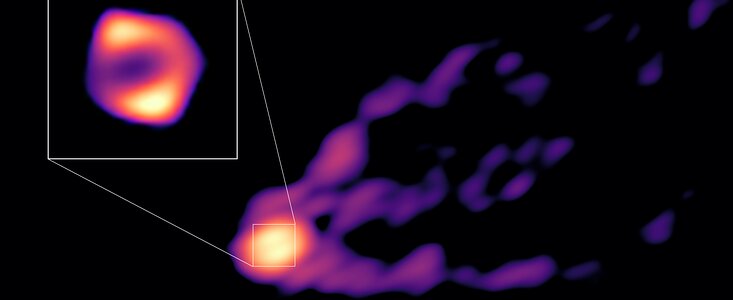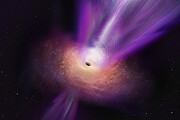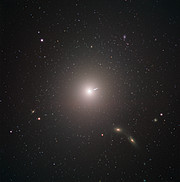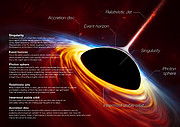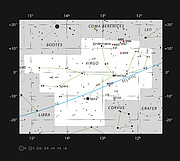Press Release
First direct image of a black hole expelling a powerful jet
26 April 2023
For the first time, astronomers have observed, in the same image, the shadow of the black hole at the centre of the galaxy Messier 87 (M87) and the powerful jet expelled from it. The observations were done in 2018 with telescopes from the Global Millimetre VLBI Array (GMVA), the Atacama Large Millimeter/submillimeter Array (ALMA), of which ESO is a partner, and the Greenland Telescope (GLT). Thanks to this new image, astronomers can better understand how black holes can launch such energetic jets.
Most galaxies harbour a supermassive black hole at their centre. While black holes are known for engulfing matter in their immediate vicinity, they can also launch powerful jets of matter that extend beyond the galaxies that they live in. Understanding how black holes create such enormous jets has been a long standing problem in astronomy. “We know that jets are ejected from the region surrounding black holes,” says Ru-Sen Lu from the Shanghai Astronomical Observatory in China, “but we still do not fully understand how this actually happens. To study this directly we need to observe the origin of the jet as close as possible to the black hole.”
The new image published today shows precisely this for the first time: how the base of a jet connects with the matter swirling around a supermassive black hole. The target is the galaxy M87, located 55 million light-years away in our cosmic neighbourhood, and home to a black hole 6.5 billion times more massive than the Sun. Previous observations had managed to separately image the region close to the black hole and the jet, but this is the first time both features have been observed together. “This new image completes the picture by showing the region around the black hole and the jet at the same time,” adds Jae-Young Kim from the Kyungpook National University in South Korea and the Max Planck Institute for Radio Astronomy in Germany.
The image was obtained with the GMVA, ALMA and the GLT, forming a network of radio-telescopes around the globe working together as a virtual Earth-sized telescope. Such a large network can discern very small details in the region around M87’s black hole.
The new image shows the jet emerging near the black hole, as well as what scientists call the shadow of the black hole. As matter orbits the black hole, it heats up and emits light. The black hole bends and captures some of this light, creating a ring-like structure around the black hole as seen from Earth. The darkness at the centre of the ring is the black hole shadow, which was first imaged by the Event Horizon Telescope (EHT) in 2017. Both this new image and the EHT one combine data taken with several radio-telescopes worldwide, but the image released today shows radio light emitted at a longer wavelength than the EHT one: 3.5 mm instead of 1.3 mm. “At this wavelength, we can see how the jet emerges from the ring of emission around the central supermassive black hole,” says Thomas Krichbaum of the Max Planck Institute for Radio Astronomy.
The size of the ring observed by the GMVA network is roughly 50% larger in comparison to the Event Horizon Telescope image. "To understand the physical origin of the bigger and thicker ring, we had to use computer simulations to test different scenarios,” explains Keiichi Asada from the Academia Sinica in Taiwan. The results suggest the new image reveals more of the material that is falling towards the black hole than what could be observed with the EHT.
These new observations of M87’s black hole were conducted in 2018 with the GMVA, which consists of 14 radio-telescopes in Europe and North America [1]. In addition, two other facilities were linked to the GMVA: the Greenland Telescope and ALMA, of which ESO is a partner. ALMA consists of 66 antennas in the Chilean Atacama desert, and it played a key role in these observations. The data collected by all these telescopes worldwide are combined using a technique called interferometry, which synchronises the signals taken by each individual facility. But to properly capture the actual shape of an astronomical object it’s important that the telescopes are spread all over the Earth. The GMVA telescopes are mostly aligned East-to-West, so the addition of ALMA in the Southern hemisphere proved essential to capture this image of the jet and shadow of M87’s black hole. “Thanks to ALMA’s location and sensitivity, we could reveal the black hole shadow and see deeper into the emission of the jet at the same time,” explains Lu.
Future observations with this network of telescopes will continue to unravel how supermassive black holes can launch powerful jets. “We plan to observe the region around the black hole at the centre of M87 at different radio wavelengths to further study the emission of the jet,” says Eduardo Ros from the Max Planck Institute for Radio Astronomy. Such simultaneous observations would allow the team to disentangle the complicated processes that happen near the supermassive black hole. “The coming years will be exciting, as we will be able to learn more about what happens near one of the most mysterious regions in the Universe,” concludes Ros.
Notes
[1] The Korean VLBI Network is now also part of the GMVA, but did not participate in the observations reported here.
More information
This research was presented in the paper "A ring-like accretion structure in M87 connecting its black hole and jet" to appear in Nature (doi: 10.1038/s41586-023-05843-w)
The team is composed of Ru-Sen Lu (Shanghai Astronomical Observatory, People’s Republic of China [Shanghai]; Key Laboratory of Radio Astronomy, People’s Republic of China [KLoRA]; Max-Planck-Institut für Radioastronomie, Germany [MPIfR]), Keiichi Asada (Institute of Astronomy and Astrophysics, Academia Sinica, Taiwan, ROC [IoAaA]), Thomas P. Krichbaum (MPIfR), Jongho Park (IoAaA; Korea Astronomy and Space Science Institute, Republic of Korea [KAaSSI]), Fumie Tazaki (Simulation Technology Development Department, Tokyo Electron Technology Solutions Ltd., Japan; Mizusawa VLBI Observatory, National Astronomical Observatory of Japan, Japan [Mizusawa]), Hung-Yi Pu (Department of Physics, National Taiwan Normal University, Taiwan, ROC; IoAaA; Center of Astronomy and Gravitation, National Taiwan Normal University, Taiwan, ROC), Masanori Nakamura (National Institute of Technology, Hachinohe College, Japan; IoAaA), Andrei Lobanov (MPIfR), Kazuhiro Hada (Mizusawa; Department of Astronomical Science, The Graduate University for Advanced Studies, Japan), Kazunori Akiyama (Black Hole Initiative at Harvard University, USA; Massachusetts Institute of Technology Haystack Observatory, USA [Haystack]; National Astronomical Observatory of Japan, Japan [NAOoJ]), Jae-Young Kim (Department of Astronomy and Atmospheric Sciences, Kyungpook National University, Republic of Korea; KAaSSI; MPIfR), Ivan Marti-Vidal (Departament d’Astronomia i Astrofísica, Universitat de València, Spain; Observatori Astronòmic, Universitat de València, Spain), Jose L. Gomez (Instituto de Astrofísica de Andalucía-CSIC, Spain [IAA]), Tomohisa Kawashima (Institute for Cosmic Ray Research, The University of Tokyo, Japan), Feng Yuan (Shanghai; Key Laboratory for Research in Galaxies and Cosmology, Chinese Academy of Sciences, People’s Republic of China; School of Astronomy and Space Sciences, University of Chinese Academy of Sciences, People’s Republic of China [SoAaSS]), Eduardo Ros (MPIfR), Walter Alef (MPIfR), Silke Britzen (MPIfR), Michael Bremer (Institut de Radioastronomie Millimétrique, France [IRAMF]), Avery E. Broderick (Department of Physics and Astronomy, University of Waterloo, Canada [Waterloo]; Waterloo Centre for Astrophysics, University of Waterloo, Canada; Perimeter Institute for Theoretical Physics, Canada), Akihiro Doi (The Institute of Space and Astronautical Science, Japan Aerospace Exploration Agency, Japan; Department of Space and Astronautical Science, SOKENDAI, Japan [SOKENDAI]), Gabriele Giovannini (Dipartimento di Fisica e Astronomia, Università di Bologna, Italy; Istituto di Radio Astronomia, INAF, Bologna, Italy [INAF]), Marcello Giroletti (INAF), Paul T. P. Ho (IoAaA), Mareki Honma (Mizusawa; Hachinohe; Department of Astronomy, The University of Tokyo, Japan), David H. Hughes (Instituto Nacional de Astrofísica, Mexico), Makoto Inoue (IoAaA), Wu Jiang (Shanghai), Motoki Kino (NAOoJ; Kogakuin University of Technology and Engineering, Japan), Shoko Koyama (Niigata University, Japan; IoAaA), Michael Lindqvist (Department of Space, Earth and Environment, Chalmers University of Technology, Sweden [Chalmers]), Jun Liu (MPIfR), Alan P. Marscher (Institute for Astrophysical Research, Boston University, USA), Satoki Matsushita (IoAaA), Hiroshi Nagai (NAOoJ; SOKENDAI), Helge Rottmann (MPIfR), Tuomas Savolainen (Department of Electronics and Nanoengineering, Aalto University, Finland; Metsähovi Radio Observatory, Finland [Metsähovi]; MPIfR), Karl-Friedrich Schuster (IRAMF), Zhi-Qiang Shen (Shanghai; KLoRA), Pablo de Vicente (Observatorio de Yebes, Spain [Yebes]), R. Craig Walker (National Radio Astronomy Observatory, Socorro, USA), Hai Yang (Shanghai; SoAaSS), J. Anton Zensus (MPIfR), Juan Carlos Algaba (Department of Physics, Universiti Malaya, Malaysia), Alexander Allardi (University of Vermont, USA), Uwe Bach (MPIfR), Ryan Berthold (East Asian Observatory, USA [EAO]), Dan Bintley (EAO), Do-Young Byun (KAaSSI; University of Science and Technology, Daejeon, Republic of Korea), Carolina Casadio (Institute of Astrophysics, Heraklion, Greece; Department of Physics, University of Crete, Greece), Shu-Hao Chang (IoAaA), Chih-Cheng Chang (National Chung-Shan Institute of Science and Technology, Taiwan, ROC [Chung-Shan]), Song-Chu Chang (Chung-Shan), Chung-Chen Chen (IoAaA), Ming-Tang Chen (Institute of Astronomy and Astrophysics, Academia Sinica, USA [IAAAS]), Ryan Chilson (IAAAS), Tim C. Chuter (EAO), John Conway (Chalmers), Geoffrey B. Crew (Haystack), Jessica T. Dempsey (EAO; Astron, The Netherlands [Astron]), Sven Dornbusch (MPIfR), Aaron Faber (Western University, Canada), Per Friberg (EAO), Javier González García (Yebes), Miguel Gómez Garrido (Yebes), Chih-Chiang Han (IoAaA), Kuo-Chang Han (System Development Center, National Chung-Shan Institute of Science and Technology, Taiwan, ROC), Yutaka Hasegawa (Osaka Metropolitan University, Japan [Osaka]), Ruben Herrero-Illana (European Southern Observatory, Chile), Yau-De Huang (IoAaA), Chih-Wei L. Huang (IoAaA), Violette Impellizzeri (Leiden Observatory, the Netherlands; National Radio Astronomy Observatory, Charlottesville, USA [NRAOC]), Homin Jiang (IoAaA), Hao Jinchi (Electronic Systems Research Division, National Chung-Shan Institute of Science and Technology, Taiwan, ROC), Taehyun Jung (KAaSSI), Juha Kallunki (Metsähovi), Petri Kirves (Metsähovi), Kimihiro Kimura (Japan Aerospace Exploration Agency, Japan), Jun Yi Koay (IoAaA), Patrick M. Koch (IoAaA), Carsten Kramer (IRAMF), Alex Kraus (MPIfR), Derek Kubo (IAAAS), Cheng-Yu Kuo (National Sun Yat-Sen University, Taiwan, ROC), Chao-Te Li (IoAaA), Lupin Chun-Che Lin (Department of Physics, National Cheng Kung University, Taiwan, ROC ), Ching-Tang Liu (IoAaA), Kuan-Yu Liu (IoAaA), Wen-Ping Lo (Department of Physics, National Taiwan University, Taiwan, ROC; IoAaA), Li-Ming Lu (Chung-Shan), Nicholas MacDonald (MPIfR), Pierre Martin-Cocher (IoAaA), Hugo Messias (Joint ALMA Observatory, Chile; Osaka), Zheng Meyer-Zhao (Astron; IoAaA), Anthony Minter (Green Bank Observatory, USA), Dhanya G. Nair (Astronomy Department, Universidad de Concepción, Chile), Hiroaki Nishioka (IoAaA), Timothy J. Norton (Center for Astrophysics | Harvard & Smithsonian, USA [CfA]), George Nystrom (IAAAS), Hideo Ogawa (Osaka), Peter Oshiro (IAAAS), Nimesh A. Patel (CfA), Ue-Li Pen (IoAaA), Yurii Pidopryhora (MPIfR; Argelander-Institut für Astronomie, Universität Bonn, Germany), Nicolas Pradel (IoAaA), Philippe A. Raffin (IAAAS), Ramprasad Rao (CfA), Ignacio Ruiz (Institut de Radioastronomie Millimétrique, Granada, Spain [IRAMS]), Salvador Sanchez (IRAMS), Paul Shaw (IoAaA), William Snow (IAAAS), T. K. Sridharan (NRAOC; CfA), Ranjani Srinivasan (CfA; IoAaA), Belén Tercero (Yebes), Pablo Torne (IRAMS), Thalia Traianou (IAA; MPIfR), Jan Wagner (MPIfR), Craig Walther (EAO), Ta-Shun Wei (IoAaA), Jun Yang (Chalmers), Chen-Yu Yu (IoAaA).
This research has made use of data obtained with the Global Millimeter VLBI Array (GMVA), which consists of telescopes operated by the Max-Planck-Institut für Radioastronomie (MPIfR), Institut de Radioastronomie Millimétrique (IRAM), Onsala Space Observatory (OSO), Metsähovi Radio Observatory (MRO), Yebes, the Korean VLBI Network (KVN), the Green Bank Telescope (GBT) and the Very Long Baseline Array (VLBA).
The Atacama Large Millimeter/submillimeter Array (ALMA), an international astronomy facility, is a partnership of ESO, the U.S. National Science Foundation (NSF) and the National Institutes of Natural Sciences (NINS) of Japan in cooperation with the Republic of Chile. ALMA is funded by ESO on behalf of its Member States, by NSF in cooperation with the National Research Council of Canada (NRC) and the National Science and Technology Council (NSTC) in Taiwan and by NINS in cooperation with the Academia Sinica (AS) in Taiwan and the Korea Astronomy and Space Science Institute (KASI). ALMA construction and operations are led by ESO on behalf of its Member States; by the National Radio Astronomy Observatory (NRAO), managed by Associated Universities, Inc. (AUI), on behalf of North America; and by the National Astronomical Observatory of Japan (NAOJ) on behalf of East Asia. The Joint ALMA Observatory (JAO) provides the unified leadership and management of the construction, commissioning and operation of ALMA.
The Greenland Telescope (GLT) retrofit, rebuild, and operation are led by the Academia Sinica, Institute of Astronomy and Astrophysics (ASIAA) and the Smithsonian Astrophysical Observatory (SAO).
The European Southern Observatory (ESO) enables scientists worldwide to discover the secrets of the Universe for the benefit of all. We design, build and operate world-class observatories on the ground — which astronomers use to tackle exciting questions and spread the fascination of astronomy — and promote international collaboration in astronomy. Established as an intergovernmental organisation in 1962, today ESO is supported by 16 Member States (Austria, Belgium, Czechia, Denmark, France, Finland, Germany, Ireland, Italy, the Netherlands, Poland, Portugal, Spain, Sweden, Switzerland and the United Kingdom), along with the host state of Chile and with Australia as a Strategic Partner. ESO’s headquarters and its visitor centre and planetarium, the ESO Supernova, are located close to Munich in Germany, while the Chilean Atacama Desert, a marvellous place with unique conditions to observe the sky, hosts our telescopes. ESO operates three observing sites: La Silla, Paranal and Chajnantor. At Paranal, ESO operates the Very Large Telescope and its Very Large Telescope Interferometer, as well as survey telescopes such as VISTA. Also at Paranal ESO will host and operate the Cherenkov Telescope Array South, the world’s largest and most sensitive gamma-ray observatory. Together with international partners, ESO operates ALMA on Chajnantor, a facility that observes the skies in the millimetre and submillimetre range. At Cerro Armazones, near Paranal, we are building “the world’s biggest eye on the sky” — ESO’s Extremely Large Telescope. From our offices in Santiago, Chile we support our operations in the country and engage with Chilean partners and society.
Links
- Research paper
- Photos of ALMA
- For journalists: subscribe to receive our releases under embargo in your language
- For scientists: got a story? Pitch your research
Contacts
Ru-Sen Lu
Shanghai Astronomical Observatory, Chinese Academy of Sciences
Shanghai, People’s Republic of China
Tel: +86-21-34776078
Email: rslu@shao.ac.cn
Keiichi Asada
Institute of Astronomy and Astrophysics, Academia Sinica
Taipei, Taiwan, ROC
Tel: +886-2-2366-5410
Email: asada@asiaa.sinica.edu.tw
Thomas P. Krichbaum
Max-Planck-Institut für Radioastronomie
Bonn, Germany
Tel: +49 228 525 292
Email: tkrichbaum@mpifr.de
Kazuhiro Hada
National Astronomical Observatory of Japan
Oshu, Japan
Tel: +81-197-22-7129
Email: kazuhiro.hada@nao.ac.jp
Juan Carlos Muñoz Mateos
ESO Media Officer
Garching bei München, Germany
Tel: +49 89 3200 6670
Email: press@eso.org
About the Release
| Release No.: | eso2305 |
| Name: | Messier 87 |
| Type: | Local Universe : Galaxy : Component : Central Black Hole |
| Facility: | Atacama Large Millimeter/submillimeter Array |
| Science data: | 2023Natur.616..686L |
